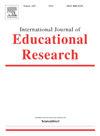Unveiling the Interplay: Capital expenditures, capital stock, racial composition, and educational attainment in U.S. schools
IF 2.6
3区 教育学
Q1 EDUCATION & EDUCATIONAL RESEARCH
引用次数: 0
Abstract
This study examines the impacts of capital expenditures and stock on educational attainment using a comprehensive dataset from 39 states (2011–2019) and employing instrumental variables (IV) techniques to address gaps in single-state studies by enhancing causal inference through broader data coverage. It uniquely investigates how racial composition moderates these impacts, offering fresh insights into the relationship between racial composition, capital spending, and student outcomes. Crucially, the findings underscore significant interaction effects between racial composition and educational outcomes, shedding light on why previous studies have reported inconclusive impacts of capital expenditures and stock on educational attainment. While construction expenditures initially enhance math and Reading/Language Arts (RLA) scores, their effects turn negative in districts with higher percentages of white students. High school graduation rates follow a similar pattern. Notably, capital stock exhibits initial negative impacts on proficiency scores that reverse positively as the percentage of white students increases. Conversely, capital stock generally improves graduation rates, albeit with diminishing returns in districts with more white students. These results highlight the complex interplay between racial composition and educational infrastructure, emphasizing the need for nuanced policy approaches. By considering how racial composition influences the effectiveness of capital investments, this study offers valuable guidance for policymakers aiming to optimize educational spending to achieve the most meaningful impact.
求助全文
约1分钟内获得全文
求助全文
来源期刊

International Journal of Educational Research
EDUCATION & EDUCATIONAL RESEARCH-
CiteScore
6.20
自引率
3.10%
发文量
141
审稿时长
21 days
期刊介绍:
The International Journal of Educational Research publishes regular papers and special issues on specific topics of interest to international audiences of educational researchers. Examples of recent Special Issues published in the journal illustrate the breadth of topics that have be included in the journal: Students Perspectives on Learning Environments, Social, Motivational and Emotional Aspects of Learning Disabilities, Epistemological Beliefs and Domain, Analyzing Mathematics Classroom Cultures and Practices, and Music Education: A site for collaborative creativity.
 求助内容:
求助内容: 应助结果提醒方式:
应助结果提醒方式:


